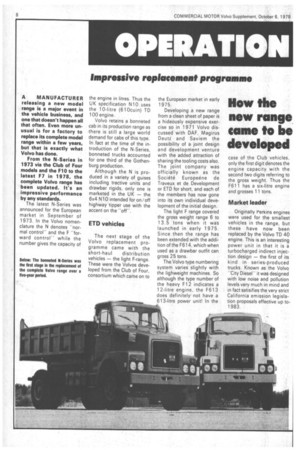A MANUFACTURER releasing a new model range is a major
Page 92

If you've noticed an error in this article please click here to report it so we can fix it.
event in the vehicle business, and one that doesn't happen all that often. Even more unusual is for a factory to replace its complete model range within a few years, but that is exactly what Volvo has done.
From the N-Series in 1973 via the Club of Four models and the F10 to the latest F7 in 1978, the complete Volvo range has been updated. It's an impressive performance by any standards.
The latest N-Series was announced for the European market in September of 1973. In the Volvo nomenclature the N denotes "normal control" and the F "forward controlwhile the number gives the capacity of
the engine in litres. Thus the UK specification N10 uses the 10-litre (610cuin) TD 100 engine.
Volvo retains a bonneted cab in its production range as .there is still a large world demand for cabs of this type. In fact at the time of the introduction of the N-Series, bonneted trucks accounted for one third of the Gothenburg production.
Although the N is produced in a variety of guises including tractive units and drawbar rigids, only one is marketed in the UK — the 6x4 N10 intended for on/off highway tipper use with the accent on the "off".
ETD vehicles
The next stage of the Volvo replacement programme came with the short-haul distribution vehicles — the light F-range. These were the Volvos developed from the Club of Four, consortium which came on to the European market in early 1975.
Developing a new range from a clean sheet of paper is a hideously expensive exercise so in 1971 Volvo discussed with DAF, Magirus Deutz and Saviem the possibility of a joint design and development venture with the added attraction of sharing the tooling costs also. The joint company was officially known as the Societe Europeene de Traveux et de Development or ETD for short, and each of the members has now gone into its own individual development of the initial design.
The light F range covered the gross weight range 6 to 13.5 tons when it was launched in early 1975. Since then the range has been extended with the addition of the F614, which when used as a drawbar outfit can gross 25 tons.
The Volvo type numbering system varies slightly with the lighweight machines. So although the type number of the heavy F12 indicates a 12-litre engine, the F613 does definitely not have a 613-litre power unit! In the


























































































































































